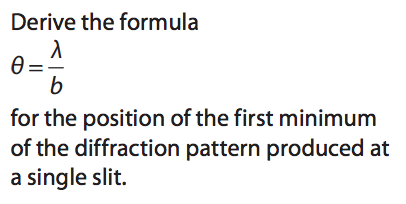IB IB Physics SL FlashCards sobre Option A. Sight & Wave Phenomena, criado por mdabella em 22-02-2015.
Pin adicionado em
26
0
0
Sem etiquetas
|
|
Criado por mdabella
quase 10 anos atrás
|
|
Fechar
|
|
Criado por mdabella
quase 10 anos atrás
|
|

A.1.1 Describe the basic structure of the human eye.
A.1.2 State and explain the process of depth of vision & accommodation
A.1.2 State and explain the process of depth of vision & accommodation (diagram)
A.1.3 State that the retina contains the rods and cones, and describe the variation in density across the surface of the retina.
A.1.4 Describe the function of the rods and cones in photopic and scotopic vision. (Spectral Response Graph)
A.1.4 Describe the function of the rods and cones in photopic and scotopic vision. (Table + Colour Blindness)
A.1.5 Describe colour mixing of light by addition and subtraction
A.2.1 Describe the nature of standing
(stationary) waves.
A.2.2 Explain the formation of
one-dimensional standing waves.
A.2.3 Discuss the modes of vibration of
strings and air in open and in closed
pipes.
A.2.4 Compare standing waves and
travelling waves.
A.3.1 Describe what is meant by the DOPPLER EFFECT.
A.3.2 Explain the Doppler effect by
reference to wavefront diagrams for
moving-detector situations.
A.3.2 Explain the Doppler effect by
reference to wavefront diagrams for
moving-source situations.
A.3.5 Solve problems on the Doppler effect for electromagnetic waves using the approximation

A.3.6 Outline an example in which the
Doppler effect is used to measure
speed.
A.2.5 Solve problems involving standing waves.
A.3.3 Apply the Doppler effect equations
for sound.
A.4.1 Sketch the variation with angle of
diffraction of the relative intensity of
light diffracted at a single slit.
A.4.1 Explain the meaning of diffraction.

A.4.3 Solve problems involving single-slit
diffraction.
A.4.3 Draw the diagram for single-slit diffraction.
A.5.1 Sketch the variation with angle of
diffraction of the relative intensity of
light emitted by two point sources
that has been diffracted at a single
slit.
A.5.2 State the Rayleigh criterion for images of two sources to be just resolved.
A.5.3 Describe the significance of resolution in the development of devices
such as CDs and DVDs, the electron
microscope and radio telescopes.
A.5.4 Solve problems involving resolution (hint: pupil of the eyes + equation)
A.6.1 Describe what is meant by polarized
light.
A.6.2 Describe polarization by reflection. (using light or microwaves)
A.6.2 Describe polarization by reflection. (Use of Sunglasses)
A.6.3 State and apply Brewster's Law
A.6.4 Explain the terms polarizer and
analyser.
A.6.5 Calculate the intensity of a
transmitted beam of polarized light
using Malus’ law.
A.6.6 Describe what is meant by an optically active substance.
A.6.7 Describe the use of polarization in the determination of concentrations of solutions.
A.6.8 Outline qualitatively how polarization may be used in stress analysis.
A.6.9 Outline qualitatively the action of Liquid Crystal Displays (LCDs).

 Ocultar acertos
Ocultar acertos